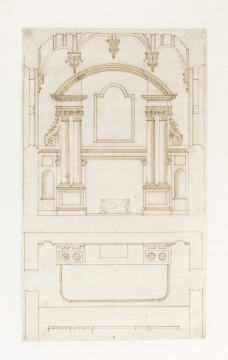Scale
5 feet to 1 inch
Inscribed
In pencil at top left, 66
Signed and dated
- Undated, but datable between December 1710 and January 1711
Medium and dimensions
Pen and brown ink over graphite under-drawing; on laid paper inlaid in C19 Whatman wove paper mount; 358 x 214
Hand
William Dickinson
Watermark
Strasbourg Lily (no 4WR)
Notes
This drawing is the finished, accepted scheme, from a preliminary design in Dickinson's hand in the British Museum dated 5 December 1710 (see Thurley, Hampton Court, fig. 201), which shows alternatives for the design of the reredos, the left version of which was adopted here, and drawn more carefully as a full elevation, accompanied by a side elevation (2; 111/51). As work began on the new altarpiece and reredos in January 1711, this revised drawing was probably made shortly after the preliminary design. The two-column frame was the grander of the two options in the preliminary design. As Thurley notes, Anne was fervently committed to upholding the Anglican faith and on her accession had made plans to enlarge the chapel at St James's Palace, in order to give it the 'form of a cathedral' (Thurley 2003, p. 217). This unexecuted work anticipated her enrichment of the Chapel Royal at Hampton Court. The design omits the carved enrichment around the reredos panel and within the end-panels of the broken tympanum that is shown on the preliminary design, but this was carved on the reredos itself, presumably by Gibbons (Thurley, fig. 202). Dickinson's hand is recognisable from his scale bar convention, his shaky freehand drawing, his mid-brown ink, and the general looseness of his ruled and freehand line drawing and shading, all of which distinguish his techniques from those of his older colleague Nicholas Hawskmoor (compare also Dickinson's designs at 111/49, 50).
Literature
Not in Wren Society
Level
Drawing
Digitisation of the Drawings Collection has been made possible through the generosity of the Leon Levy Foundation
Sir John Soane's collection includes some 30,000 architectural,
design and topographical drawings which is a very important resource for
scholars worldwide. His was the first architect’s collection to attempt to
preserve the best in design for the architectural profession in the future, and
it did so by assembling as exemplars surviving drawings by great Renaissance
masters and by the leading architects in Britain in the 17th and 18th centuries
and his near contemporaries such as Sir William Chambers, Robert Adam and
George Dance the Younger. These drawings sit side by side with 9,000 drawings
in Soane’s own hand or those of the pupils in his office, covering his early
work as a student, his time in Italy and the drawings produced in the course of
his architectural practice from 1780 until the 1830s.
Browse (via the vertical menu to the left) and search results for Drawings include a mixture of
Concise catalogue records – drawn from an outline list of the collection – and
fuller records where drawings have been catalogued in more detail (an ongoing
process).


